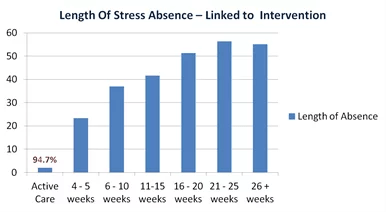Strengthen the wellbeing & resilience of your team.
- Find the right EAP for your budget
- Understand the opportunities and pitfalls
- Ensure a hassle-free set-up & smooth operation
Strengthen the wellbeing & resilience of your team.











An Employee Assistance Programme (or EAP) is designed to help employees cope with life’s challenges. It’s a proactive way of assisting workers with a range of emotional and psychological issues, big and small.
An EAP can help employees deal with the stresses and strains associated with:
However, employees do not need to be going through a traumatic event in order to benefit. The resources provided within an EAP are designed to improve general emotional resilience, achieve inner calm and generally ease stress levels.
Many businesses – big and small – invest in programmes provided by third-party companies. While the company pays a relatively small amount to provide the support, employees receive the service for free.
EAPs are provided via digital platforms and apps which may include services such as:
The range of services included will depend on the provider and/or the package they offer. Many EAPs can be tailored to the needs of the business.
or email us at [email protected]
Employee Assistance Programmes are a relatively low cost means of safeguarding and improving the health and wellbeing of your workforce. In recent years we’ve seen more businesses incorporating an EAP and an increasing number of digital services catering for this growing market.
A 2020 CIPD survey revealed that 74% of respondents were using EAPs to support their employees, an increase from 52% in 2016.
Some of the key benefits of implementing an EAP include:
A study by Nunes et al showed that levels of absenteeism were significantly reduced among users of EAP services compared to employees not using them.
While there is no “silver bullet” solution to the complex issue of mental and emotional wellbeing, an Employee Assistance Programme can cover a large part of the territory. Services and features can be tailored to the needs of a business, while the employee can utilise the support mechanisms which best meet their needs.
Most EAPs offer the chance for employers to gather insight into services they use the most. By monitoring anonymously collected usage stats, it’s possible to gain a better understanding of the risk factors which exist within a business. This allows HR teams and company bosses to offer better targeted support services within the EAP. It also highlights areas of support which could be offered beyond the programme – for example, health insurance, corporate away days, flexible working arrangements and other employee benefits which could aid employee emotional wellbeing.
Many of the EAPs we handle at Engage are included as added value services through employee benefit packages such as: Group Health Insurance, Group Income Protection and Death-in-Service Insurance.
If the Employee Assistance Programme is added on to an insurance product in this way, then there will be no additional cost as it is included within the insurance premium. However, if you require a fully comprehensive plan, then we will need to check if the ‘added EAP’ delivers enough support – some insurance providers will only provide a basic EAP in this way.
According to the ‘UK Employee Assistance Professionals Association’ the price can vary from £3.50 per employee each year for a company with 2000 staff, to £8 per employee, each year for a company with 500 employees. Another factor influencing the cost will be the breadth of services included in the EAP.
The following list of EAP providers are registered with the EAPA, a not-for-profit organisation which promotes and upholds industry standards. If you’d like independent advice to help find the right Employee Assistance Programme for your business, then call our expert brokers for FREE on +44 (0)1273 974419.
It’s worth reiterating that programmes can also be packaged within a health insurance or income protection scheme too.
If employers wish to maximise their return on investment and genuinely improve the lives of their workforce, they need to promote the service.
All EAP providers will provide helpful promotional materials, such as posters and leaflets, which can be displayed in communal areas. But employers can go further still.
Many employers now incorporate the Employee Assistance Programme into their management training, and ensure that staff are continually reminded of its features during performance conversations and/or one-to-one feedback sessions.
Direct managers are often the first to notice a change in employee behaviour and are usually best placed to guide people to the service.
Finally, whilst the use of an EAP by employees is confidential, EAP providers offer important usage insight. This data can assist in understanding which risks are most prominent within the business. This enables the employer to deploy resources more appropriately, ensuring that any health and wellbeing budget is being spent in the correct areas.
For example, if CBT tools are being used extensively across the workforce, it would suggest heightened workplace stress. It would then be sensible to identify the possible causes and address them – before they become a cause of absenteeism.
Mental health is one of the greatest causes of sickness absence in the UK. The overall rate of sickness absence fell from 2.2% to 1.8% between 2010 and 2020, according to a 2020 labour market report by the ONS. Yet absence due to mental health in this period has actually risen and the latest statistics are yet to account for the full impact of Covid-19.
However, we do know that depression or anxiety accounted for 50% of all work-related ill health cases in 2020/21, according to HSE. Meanwhile, of those suffering from work-related stress, almost half a million (449,000) said it was caused or made worse by the effects of the pandemic.
Stress Related Absence has a significant impact on productivity and the below chart, recorded over a 10-year period by a major Income Protection provider, demonstrates the important role that early intervention plays.
The table shows that when an episode of stress related absence receives intervention at week four, the average total length of absence is 24.3 weeks.
Where intervention is received between 21-25 weeks, the average total length of absence is over 55 weeks.

Many EAP providers aim to assist employers to intervene within the first seven days, prompting early discussion and support, and facilitating a faster return to work for the employee.
Read more on mental health issues caused by the Covid-19 pandemic (Morneau Shepell Mental Health Index).
“Quick to respond, knowledgeable and personable. They worked on an ideal plan for my business and it was up & running at pace.”
Digital Marketing Business, Sussex
An EAP is usually regarded as a business expense rather than a benefit in kind. This means that the employee will normally avoid paying any tax on the benefit.
There are exceptions, however.
Firstly, to be exempt, the EAP must be made available to all employees, not just to a small group, such as the management team. In the latter scenario it can be classed as a benefit in kind.
Secondly, if an employee’s friends or family are included within the remit of the EAP, this may affect its tax classification. In order to avoid tax liability, the services offered to family and friends must be restricted to issues which affect the employee too, such as family or couple’s counselling. However, if EAP services solely benefit a friend or family member, it will become a benefit in kind for tax purposes.
Need help finding the right Employee Assistance Programme for your business? Engage Health Group gives professional advice covering the whole spectrum of employee benefits – FREE of charge. Simply use the contact form on the right.
Address: Lees House, 21-23 Dyke Rd, Brighton and Hove, Brighton BN1 3FE, United Kingdom
Hours:

Engage Health Group Ltd is registered in England and Wales. Companies House (No. 10075534). Engage Health Group Ltd registered office: 1a City Gate, 185 Dyke Road, Hove, England, BN3 1TL. Engage Health Group Ltd is authorised and regulated by the Financial Conduct Authority (No 812846). Important – insurance policy benefits will cease if you stop paying the premiums on your policy.
| Cookie | Duration | Description |
|---|---|---|
| cookielawinfo-checkbox-analytics | 11 months | This cookie is set by GDPR Cookie Consent plugin. The cookie is used to store the user consent for the cookies in the category "Analytics". |
| cookielawinfo-checkbox-functional | 11 months | The cookie is set by GDPR cookie consent to record the user consent for the cookies in the category "Functional". |
| cookielawinfo-checkbox-necessary | 11 months | This cookie is set by GDPR Cookie Consent plugin. The cookies is used to store the user consent for the cookies in the category "Necessary". |
| cookielawinfo-checkbox-others | 11 months | This cookie is set by GDPR Cookie Consent plugin. The cookie is used to store the user consent for the cookies in the category "Other. |
| cookielawinfo-checkbox-performance | 11 months | This cookie is set by GDPR Cookie Consent plugin. The cookie is used to store the user consent for the cookies in the category "Performance". |
| viewed_cookie_policy | 11 months | The cookie is set by the GDPR Cookie Consent plugin and is used to store whether or not user has consented to the use of cookies. It does not store any personal data. |